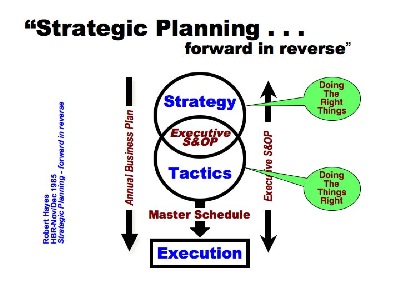




S&OP’s Role in Strategic Planning
Ready for a quiz? Here goes: Is Executive S&OP a strategic planning tool or a tactical planning tool? The answer is YES. You see, it’s both and here’s why.
In this changing world, doing the right things (strategic planning) is just as important as doing the things right (tactical planning and execution). Both must be part of the equation if a company is to be truly excellent. Executive S&OP can help with both.
Over twenty years ago, in a hallmark article in the Harvard Business Review: “Strategic Planning – Forward in Reverse,” Professor Robert Hayes stated that the traditional top-down, once a year approach to strategic planning has serious flaws (click here to view a summary of this article).
• It assumes that the world of competition is predictable and that clear paths can be charted.
• It assumes that a company’s values and needs will not change over the planning horizon, enabling managers to concern themselves with ‘static optimization’ of execution.
• It assumes that once these strategies are defined, managers can assemble the necessary resources and competencies required to execute them.
• It assumes that the responsibility for organizational success rests primarily with top management through a command and control mechanism, without multi-level collaboration.
Hayes further concluded that to continue this top down approach had the potential to put a company on a competitive playing field where it’s weak, not strong. This is because a company may not have the competencies or resources to immediately do what the market place is calling for. As a result, Hayes recommended reversing the order of steps of strategic planning process – to go from bottom up. I agree. Strategic planning must be done in both directions and in an iterative, ongoing fashion as opposed to the staccato, once-per-year approach.
Professor Hayes said further, “The trick, of course, to managing such discontinuities without alienating the organization or undermining its capabilities is to employ a patient, consensus-seeking decision process in which all parties have an opportunity to be heard.” While Hayes’ observations over twenty years ago were insightful, we had little knowledge then about how to follow his advice. Today there’s an answer: Executive S&OP can support strategic planning
The executive component of Sales & Operations Planning, known as Executive S&OP, is defined as:
“ . . . a cross-functional decision making process, involving the General Manager (President) and staff, collaboratively balancing demand and supply at the aggregate level and aligning operational plans with financial plans . . . . it enables the company’s managers to view the business holistically, providing them with a window into the future, serving as a form for discussing relevant policy and strategy as appropriate.”
 Figure #1 displays the three levels at which all companies operate – strategic, tactical, and execution. It shows the traditional Strategic Planning process to be top-down as described earlier. While Executive S&OP is primarily a tactical planning tool, its contribution to strategic planning is in closing the loop to strategic planning, providing the bottom-up view as indeed things change – internally or externally. Depending on the circumstances, the Executive Meeting within the Executive S&OP process, while normally focusing on tactical issues, can address strategic matters. Examples on the supply side include decisions on reconfiguration of the supply chain, outsourcing, and new plant location.
Figure #1 displays the three levels at which all companies operate – strategic, tactical, and execution. It shows the traditional Strategic Planning process to be top-down as described earlier. While Executive S&OP is primarily a tactical planning tool, its contribution to strategic planning is in closing the loop to strategic planning, providing the bottom-up view as indeed things change – internally or externally. Depending on the circumstances, the Executive Meeting within the Executive S&OP process, while normally focusing on tactical issues, can address strategic matters. Examples on the supply side include decisions on reconfiguration of the supply chain, outsourcing, and new plant location.
And here’s an example on the demand side: I was recently working with a company that had announced a significant price increase. One of its largest customers gave strong pushback and was not accepting the increase. This provided the company with several choices:
• Go on with the price increase as planned, risking the loss of volume from that customer
• Impose the price increase on everyone except that customer, risking the alienation and loss of volume from others, not to mention potential legal issues.
• Roll back the entire price increase and either lose margin, or find other ways of protecting margin by cutting costs.
This may not be an easy decision; it requires cross-functional participation and it cannot be resolved with tactical actions alone. It gets at strategic alternatives and their consequences. The Exec Meeting in the 5-Step Executive S&OP process is an ideal forum this type of deliberation, discussion, and decision-making.
While the tools of simulation and risk management – key elements within Executive S&OP – are always helpful in evaluating tactical alternatives, they can also be even useful with these types of strategic issues. Thus, Executive S&OP sits at the intersect between strategic and tactical planning – keeping them in sync.
Without Executive S&OP, Hayes’ thoughts and observations about top-down versus bottom-up strategic planning are mostly theoretical. With Executive S&OP, however, they can be put to work in the real world. Give it a try – you won’t be alone.